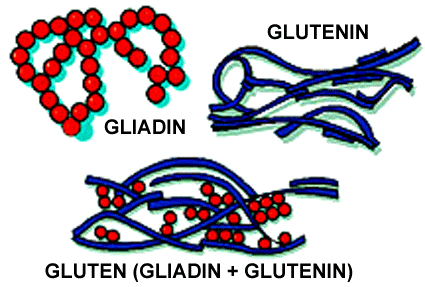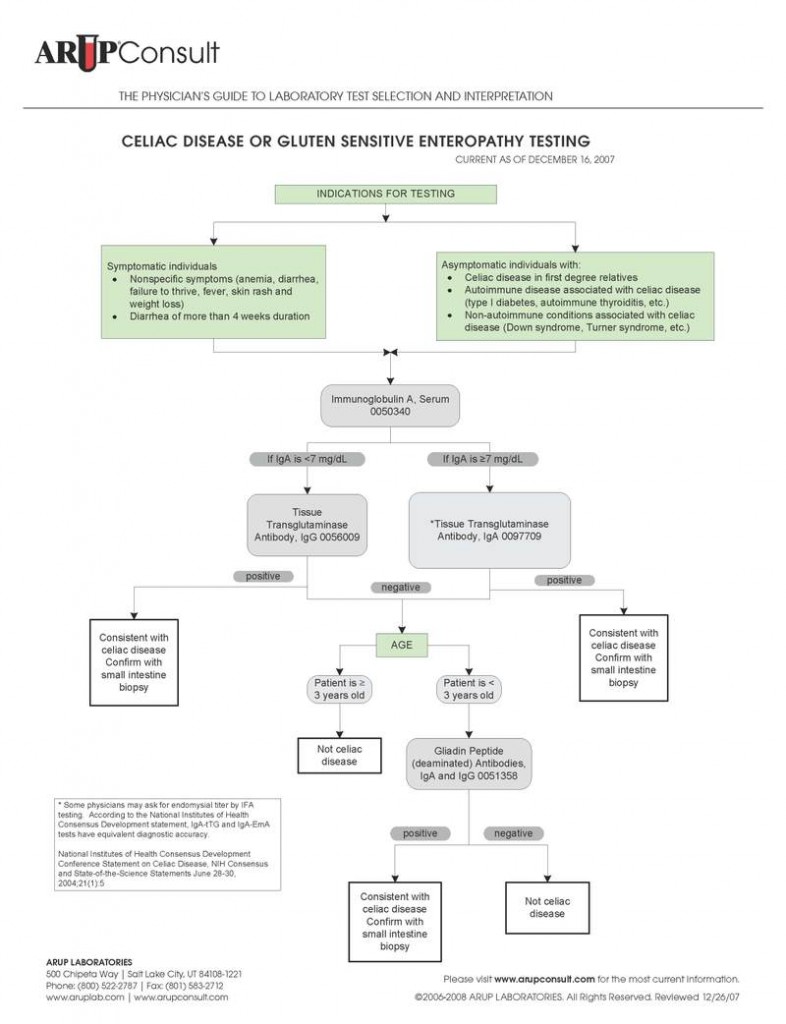What is gluten?
Gluten is a protein found in some grains, especially wheat.
Technically, “gluten” is a term applied specifically to the combination of the prolamin proteins called gliadins and the glutelin proteins called glutenins that are found in wheat (see below).

“Gluten” has also been used generically to refer to prolamin and glutelin protein mixtures found in other cereal grains.
Gluten is found in the following grains:
- Wheat
- Barley
- Bulgur
- Rye
- Spelt
- Oats (possibly, the proportion of individuals with gluten sensitivity that are also sensitive to the storage proteins in oats is likely less than 1%)
- Kamut
- Triticale
- Semolina
- Pumpernickel
- Farro
Gluten is not found in the following grains:
- Rice (all varieties)
- Buckwheat
- Teff
- Amaranth
- Quinoa
- Corn
- Hominy
- Millet
Gluten adds elasticity to dough. It makes bagels and breads chewy, pizza dough stretchy, and pasta noodles elastic so that they can be pulled through the pasta press without breaking when they are made. Thus, getting a desirable texture in gluten free baked goods can be difficult.
Gluten is sometimes referred to as “seitan” or “wheat meat” and can be used in recipes.

What you should know about gluten
Gluten intolerance is the most common food sensitivity disease of the intestine. It affects about 15% of the US population, although since many people are undiagnosed, it may be even higher.
Consuming gluten triggers an immune response in gluten-intolerant people.
When we swallow a food antigen (like gluten) the body goes to work fighting it. White cells recognize the antigens and destroy them. When the white cells are overwhelmed, inflammation results.
Short- and long-term effects
Initially, gluten intolerance can manifest as diarrhea, bloating, flatulence, uncomfortable stools, weight loss and malnutrition. Other inflammatory symptoms can also result. (See below for a list.)
For an intolerant person, regularly consuming gluten will result in long-term damage, including intestinal scarring and nutrient malabsorption.
Chronic inflammation can atrophy and flatten the intestinal lining, which impairs digestion.
Gluten and other inflammatory proteins can weaken the intestinal wall by opening tight junctions (see figure below).
When the intestinal lining is compromised, more food antigens can then cross the barrier and enter the bloodstream. Other pathogens get into general circulation. This causes the body to produce more antibodies, attempting to fight the antigens. It can also mean that depending on the pathogen, the body is more susceptible to harmful micro-organisms and unwanted invaders.

How do I know if I am intolerant?
Because these processes can trigger widespread effects throughout the body, it can often be challenging to diagnose gluten intolerance right away. Digestive upset is one of the most common and obvious symptoms; this can include gastric reflux (heartburn), bloating, gas, abdominal pain, constipation, and diarrhea.
In addition, there can be other symptoms — often symptoms that we wouldn’t assume to be related to what we’ve eaten. However, if we understand gluten intolerance as a wide-ranging systemic inflammatory response, then this broad range of symptoms makes more sense. These can include:
- Weight loss or weight gain
- Nutritional deficiencies due to malabsorbtion (e.g. low iron levels)
- Fat in the stools (due to poor digestion)
- Aching joints
- Depression, anxiety, irritability and other behavioral changes
- Eczema and skin rashes
- Headaches
- Chronic fatigue and low energy
- Infertility, irregular menstrual cycle and miscarriage
- Cramps, tingling and numbness (often due to vitamin B12 malabsorption)
- Slow infant and child growth
- Decline in dental health
- Asthma and allergies
- Food cravings, especially for baked goods and sweets
Since your body makes antibodies in response to what it sees as a harmful invader, testing the serum for antibodies can identify most patients with a gluten allergy. These antibodies include:
- Anti-endomysial antibodies
- Antigliadin IgA antibodies
- Anti-tissue transglutaminase antibodies
An intestinal biopsy is also an option. Still, these tests can be inconclusive. A decisive assessment includes testing the stool for antibodies.
Not everyone has an allergic reaction to gluten. Some may simply have a sensitivity to it.
Autoimmunity to gluten involves cells that produce IgA & IgG. There is little or no IgE involvement. Most food sensitivities that engage the immune system involve IgE (see All About Food Sensitivities for more). When gluten is eliminated from the diet, those who are sensitive feel fine.
Gluten peptides, like casein peptides, may become biologically active through binding with opioid receptors and disrupt homeostasis of the body.
Why is gluten so important?
North Americans eat prodigious amounts of grains. In 1967, consumption of gluten-containing grains was 115 pounds per person. In 2003, it reached 139 pounds.
Ethnic differences
Gluten intolerance appears to be more prevalent in people of white European descent.
The estimated prevalence of gluten sensitive enteropathy (GSE) or celiac disease (CD):
- In the general U.S. population: 1 in 133
- In African-, Hispanic, and Asian-Americans: 1 in 236
- Worldwide: 1 in 266
Some experts feel that GSE was under-diagnosed in the past. Others feel that GSE is becoming more prevalent due to the agricultural revolution. Before that time, concentrated amounts of milled grain were sparse and varied.
Even with only 1% of Americans having GSE, marketers estimate that 15% to 25% of consumers want gluten-free foods. This is likely because gluten peptides are linked to other health concerns like the pathogenesis of autism and multiple sclerosis.
Those with autism may have abnormal intestinal permeability, resulting in the absorption of gluten peptides. The efficacy of a gluten free diet for reducing autism is limited based on current evidence.
Gluten might play a role in triggering schizophrenia in people with a genetic risk for the condition, as these genetic defects of the illness may result in an overload of peptides from gluten. Furthermore, those with rheumatoid arthritis may be able to improve their symptoms by incorporating a gluten-free diet. Changes in the immune system may underlie the beneficial outcome.
It’s been hypothesized that gluten can be addictive. In Food Addicts Anonymous, wheat is actually put in the same category as sugar and flour.
Summary and recommendations
If you suspect an allergy or severe intolerance to gluten, contact your physician and set up testing.
If avoidance of gluten is warranted, introduce yourself to kitchen makeover, gluten free style. See All About Kitchen Makeovers for more.
If you don’t have any type of sensitivity to gluten, it may still be beneficial to diversify grain use when possible. Rotating grains may prevent the development of any sensitivity along with diversifying your nutrient intake. Still, incorporating some grains with gluten is probably fine.

Extra credit
Gluten can also be found in:
- Modified food starch
- MSG
- Lecithin
- Emulsifiers
- Soy sauce
- Medications & supplements
- Other processed foods
A gluten free diet may lead to decreases in beneficial gut bacteria.
Freshly milled flour is typically yellow in color and has to age before it can be used (fresh flour has weak gluten and doesn’t make good bread). As fresh flour ages and reacts with the oxygen in the air, the glutens become stronger and the color also pales to off-white, like you see on store shelves.
References
Click here to view the information sources referenced in this article.
Eat, move, and live… better.©
The health and fitness world can sometimes be a confusing place. But it doesn’t have to be.
Let us help you make sense of it all with this free special report.
In it you’ll learn the best eating, exercise, and lifestyle strategies — unique and personal — for you.






Share